Mango, scientifically known as Mangifera indica L., is a tropical evergreen tree belonging to the Anacardiaceae family. Mango farming plays a crucial role in the agricultural sector, offering numerous benefits to farmers and consumers alike. Cultivating Mango trees not only provides a sustainable income source for farmers but also contributes to food security by producing nutrient-rich fruits.
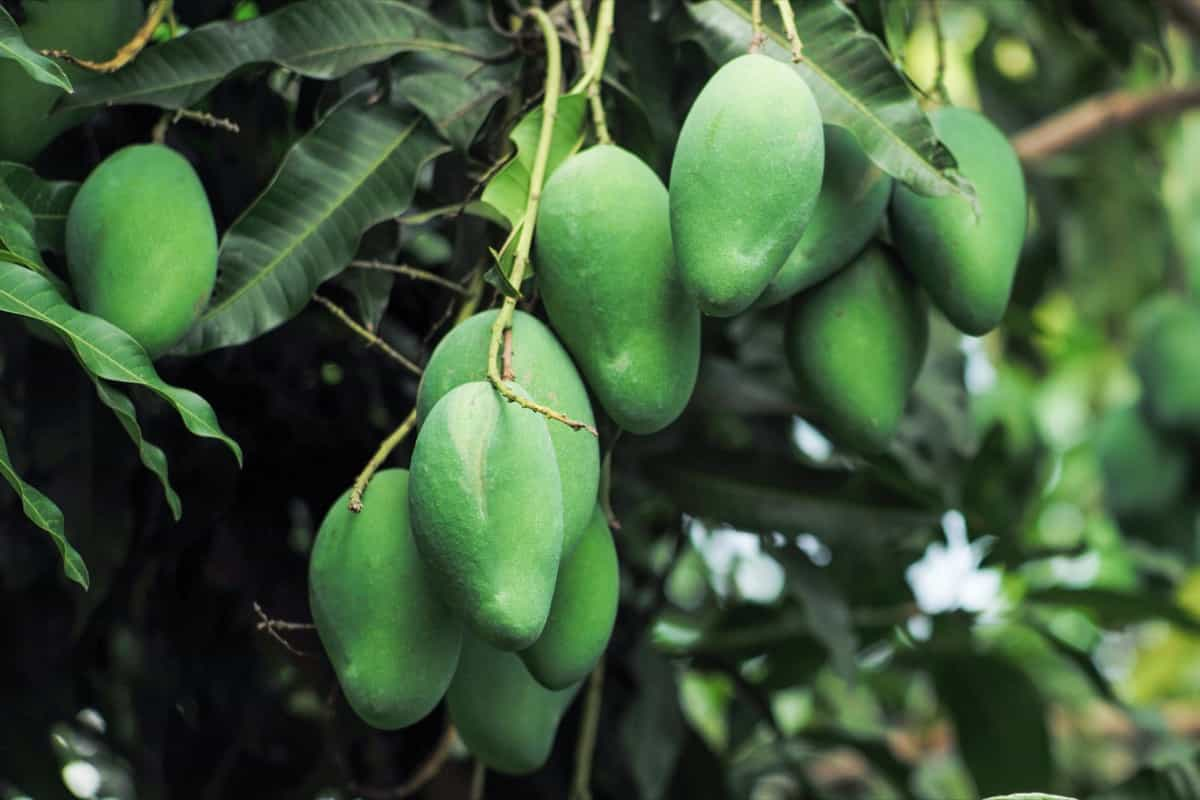
Best Mango Varieties
Choosing the right Mango varieties is crucial for a successful harvest. Varieties like Alphonso, Kensington Pride, and Tommy Atkins are popular choices among farmers worldwide. If you prefer a more fiber-free experience, consider planting the Keitt variety known for its smooth texture and minimal fibers. The Kent Mango variety is another favorite among farmers due to its large size and rich flavor profile.
Selecting the best Mango variety depends on your location, market demand, and personal preferences. Other popular varieties include the Ataulfo, Neelam, Haden Mangoes, Devgad, Kesar, Junagadh, Langra, Varanasi, Chaunsa, Kurukshetra, Badami, Bagalkot, and Haden.
Site Selection and Preparation
Mango trees thrive in warm climates with well-drained soil, so choosing a location with plenty of sunlight and good air circulation is key. Before planting Mango trees, ensure the site has adequate space for the trees to grow to their full potential. Clear any obstacles that may hinder tree growth and make sure the soil is rich in organic matter to support healthy root development.
Properly preparing the site involves testing the soil pH levels and adjusting them as needed to create an optimal growing environment for Mango trees. This step will help ensure that the trees receive essential nutrients for growth and fruit production.
Climate and Soil Requirements
Mango trees thrive in tropical and subtropical climate conditions. The ideal climate for Mango farming is characterized by hot summers and mild winters with minimal rainfall during the flowering season. Mango trees prefer well-drained soils with a pH range of 5.5-7.5, avoiding waterlogged or saline conditions that can hinder root development.
In case you missed it: Thailand All Time Mango Farming: How to Plant and Grow Katimon Mango
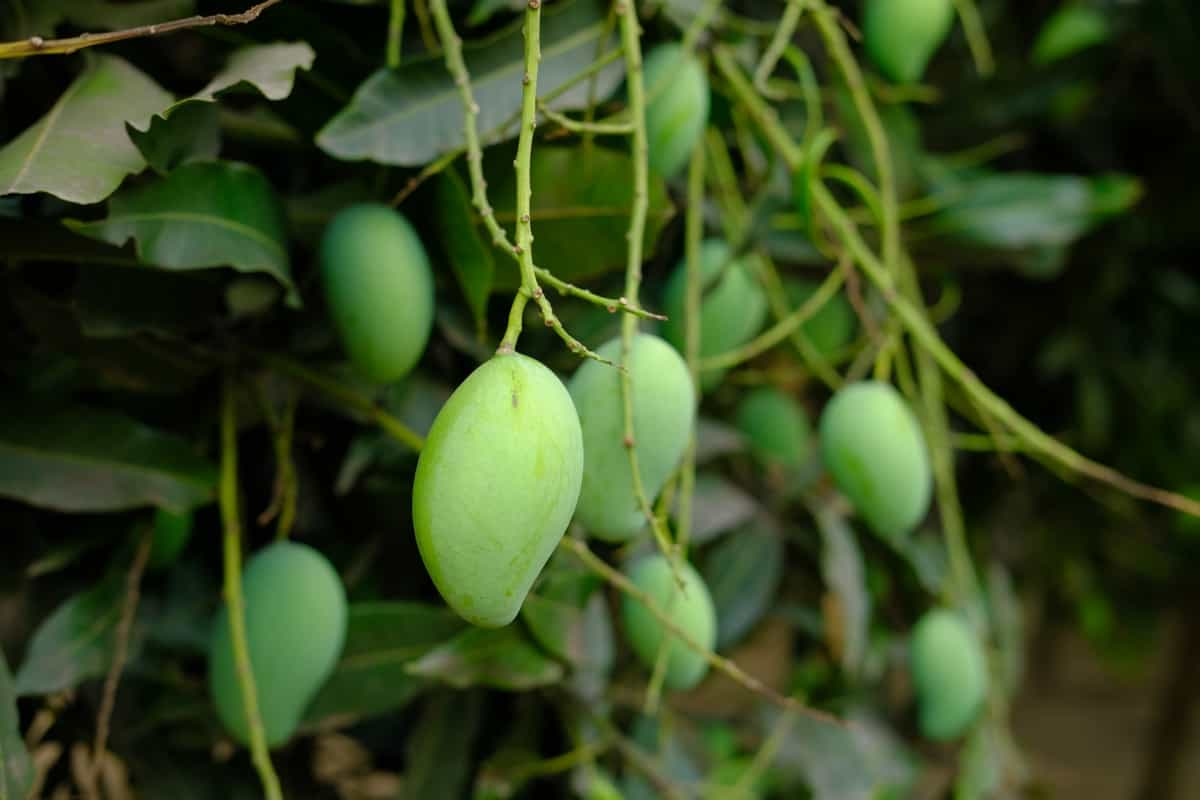
When it comes to soil requirements, sandy loam or loamy soils are preferred for optimal growth and fruit production. These soil types offer good drainage while retaining enough moisture for the tree’s needs. Additionally, Mango trees require full sun exposure to ensure vigorous growth and fruiting. Understanding the specific climate and soil conditions needed for successful Mango cultivation is crucial for maximizing yields and quality fruits.
Planting Techniques
It is crucial to select healthy and disease-free saplings. Before planting, ensure the root system is well-developed and the tree has a straight trunk. Dig a planting hole that is at least as deep as the tree’s root ball and twice as wide to allow for proper growth. Mix organic matter like compost or manure into the soil to improve its structure. Plant the tree at the same depth it was in its nursery container.
Water carefully after planting to help settle the soil around the plant roots and remove any air pockets. Mulch around the Mango tree base to suppress weeds and regulate soil temperature. Consider using support stakes if needed to help young trees establish strong roots. Regularly monitor growth progress and adjust care practices accordingly for optimal development.
Spacing and Layout of Mango Trees
Mango trees require adequate space to comfortably spread their roots and branches, allowing for proper growth and development. A recommended spacing of 10m x 10m or 8m x 8m is ideal for Mango trees, providing enough room for each tree to flourish without overcrowding. This spacing also facilitates efficient management practices such as pruning, fertilization, and pest control.
The layout of Mango trees should be planned strategically to maximize sunlight exposure and airflow throughout the orchard. Proper orientation can help prevent diseases by promoting good air circulation among the trees. Maintaining a uniform distance between each tree ensures equitable distribution of resources such as water, nutrients, and sunlight. This promotes consistent growth across the orchard, leading to a higher yield at harvest time.
Number of Mango Trees per Acre
The ideal spacing and layout of Mango trees can significantly impact the overall yield and health of your orchard. Proper spacing between Mango trees allows for adequate sunlight exposure, airflow, and nutrient distribution. The number of Mango trees per acre can change based on the variety grown and the specific conditions of your farm. On average, with proper planning and management practices in place, you can plant around 70-120 trees per acre.
Effective Drip Irrigation for Mango Orchard
This modern technique ensures that water is delivered directly to the roots of the trees, promoting healthy growth and optimal fruit production. By providing the right amount of water at the right time, drip irrigation helps in conserving water and reducing wastage. Mango trees thrive in well-drained soil, so proper irrigation is crucial for their development. Drip irrigation systems meet each tree’s specific needs, ensuring they receive adequate moisture without being overwatered.
In case you missed it: How to Grow Miyazaki Mango from Scratch: A Step-by-Step Cultivation Guide
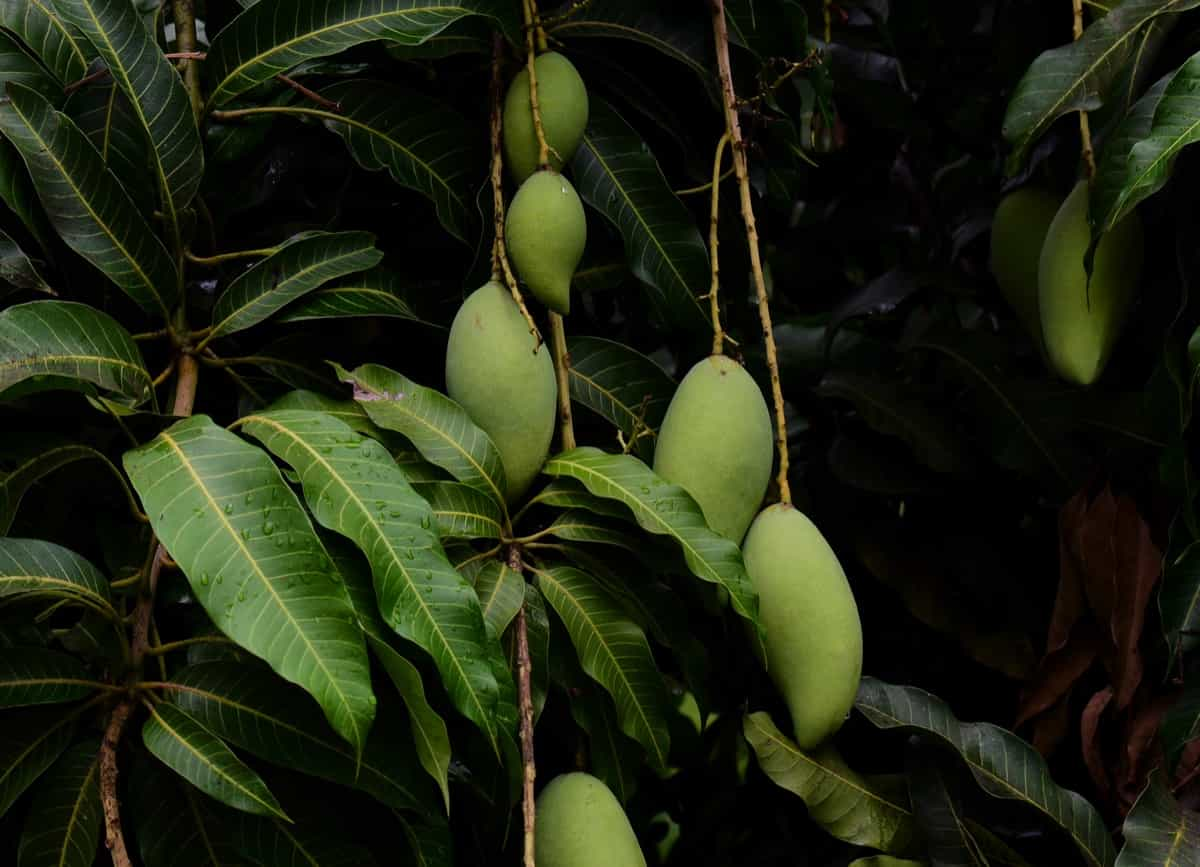
This precision watering also helps prevent diseases caused by excess moisture around the roots. With drip irrigation, farmers can better control the amount of water each tree receives, leading to improved yields and overall orchard health. It’s a sustainable practice that benefits Mango trees and contributes to water conservation efforts in agriculture.
Fertilization and Soil Management Techniques
Proper nutrient balance is essential for healthy tree growth and bountiful fruit production. Regular soil testing helps determine your orchard’s specific needs, allowing you to tailor your fertilization approach accordingly. Organic matter can improve soil fertility, promoting optimal root development in Mango trees.
Applying a balanced fertilizer mix at the right time and in the right amounts ensures that your trees receive all the nutrients they require for robust growth. Implementing sustainable practices like cover cropping can help enhance soil health, reduce erosion, and retain moisture levels within the orchard.
Pruning and Training of Mango Trees
Pruning helps maintain tree health by removing dead or diseased branches, allowing sunlight to penetrate the canopy. It also improves air circulation, reducing the risk of fungal diseases. Training involves shaping the tree for better fruiting and ease of harvesting. When pruning Mango trees, start by removing any broken or crossing branches. Trim back overly vigorous growth to encourage branching and fruiting.
Avoid heavy pruning during the planting season, as it can stress the tree. Training young Mango trees involves selecting a central leader branch and removing competing leaders. Use stakes or trellises to support young trees and guide their growth pattern. Regularly check for pests or diseases while pruning and training your Mango orchard.
Pest and Disease Management
Aphids, scales, and mealybugs are the major pests that can affect Mango trees. These insects feed on the sap of the trees, weakening them over time. To control these pests, integrated pest management practices are recommended. These practices involve a combination of cultural, biological, and chemical methods to control pest populations without harming the environment or human health.
Regular monitoring of the orchard for signs of pest infestation is essential. Early pest detection allows for timely intervention to prevent extensive damage. Additionally, maintaining proper hygiene in the orchard by removing fallen tree leaves and debris can help reduce pest pressure. For disease management, it’s important to select disease-resistant Mango varieties whenever possible. Fungal diseases like anthracnose and powdery mildew can be controlled through proper pruning techniques and fungicide applications as needed.
Weed Control Measures
Weeds compete with Mango trees for nutrients, water, and sunlight, affecting their growth. Manual weeding by hand or using tools like hoes can be effective in removing weeds around young Mango trees. Mulching is another effective weed control measure that helps suppress weed growth while conserving soil moisture and improving soil structure. Organic mulches can be applied around the base of Mango trees to prevent weed growth. Herbicides are also commonly used in weed management in large-scale Mango orchards.
In case you missed it: Unlocking Prosperity: Mastering Mango Intercropping for Doubling Farmer’s Income
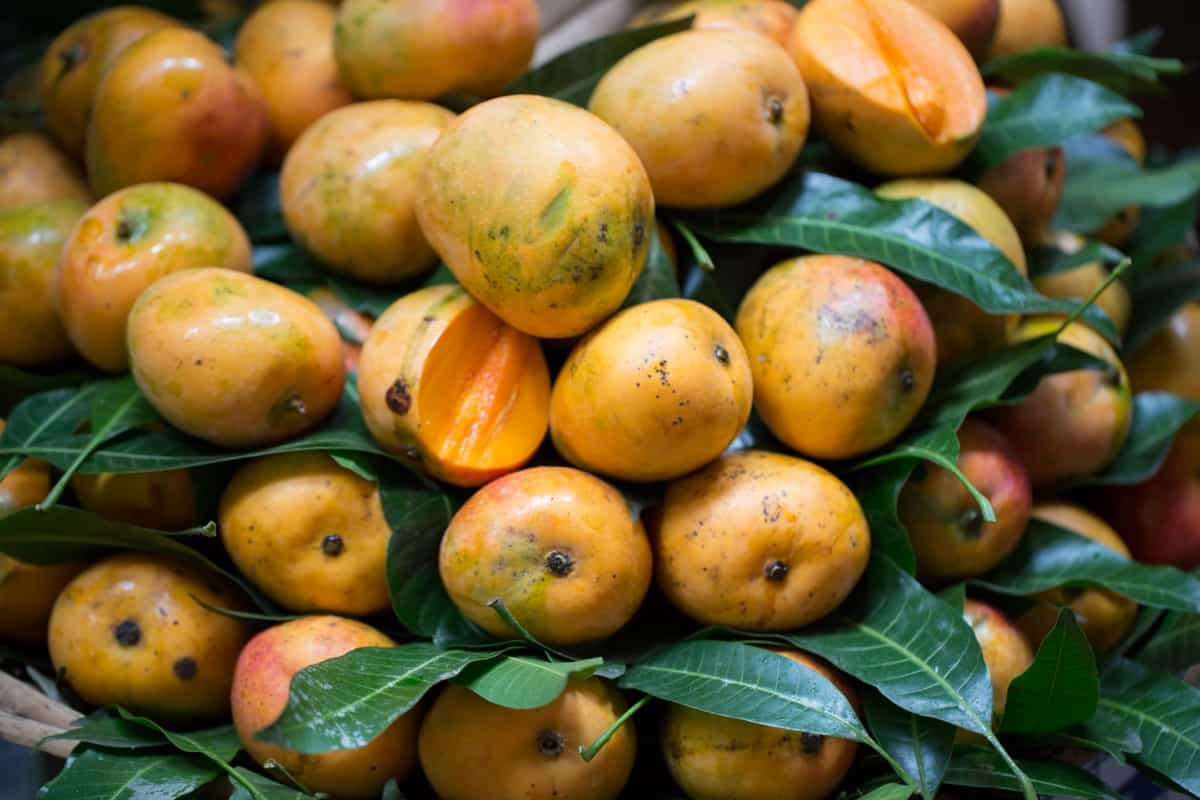
Selective herbicides target specific weed types without harming the Mango trees, ensuring effective weed control without damaging the crop. Regular monitoring of weeds is essential to identify any infestations early on and take necessary measures to prevent them from spreading throughout the orchard. By implementing proper weed control measures, farmers can maintain a healthy environment for their Mango trees to thrive and produce high-quality fruits.
Harvesting Techniques
Harvesting Mangoes is a crucial step in the cultivation process. The timing of harvesting greatly impacts the fruit quality and shelf life. Mangoes are typically harvested when they reach maturity but are still firm to touch, usually between 100-150 days after flowering. One common method of harvesting Mangoes is hand-picking them. Careful handling is essential to avoid damaging the delicate skin and flesh.
Harvesters use long-handled picking poles with baskets attached at the end to collect ripe Mangoes from tall trees safely. Another technique involves using mechanical harvesters that shake or knock down ripe fruits from the branches. While this method can be efficient for large-scale orchards, it requires proper calibration to prevent bruising or injuring the fruits during harvest.
Yield of Mango per Acre
The yield of a Mango orchard per acre depends on various factors, such as the variety of Mangoes, soil fertility, climate conditions, and management practices. On average, a Mango orchard can yield 5 to 15 tons per acre. Proper cultivation practices and care throughout the growing season are key to maximizing yields.
Post-Harvest Handling and Storage
Once the Mangoes have been carefully harvested, it is crucial to focus on post-harvest handling and storage to maintain their quality. Proper handling techniques are essential to prevent damage and bruising that can affect the fruit’s shelf life. Sorting the Mangoes based on ripeness levels ensures a consistent product for consumers.
In case you missed it: Key Rules to Get Rid of Fruit Fly in Mango: Symptoms, How to Treat, Management, Chemical, and Organic Control
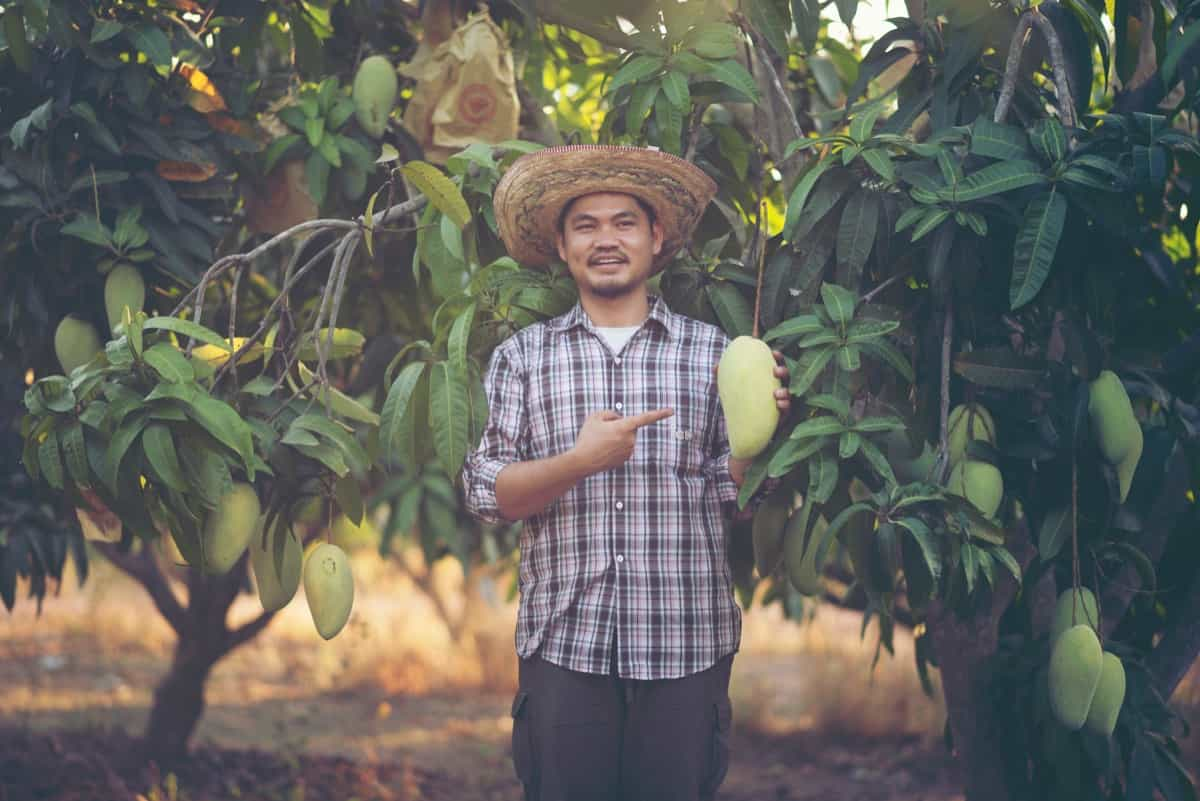
After sorting, washing the Mangoes with clean water helps remove any dirt or residues. Drying them thoroughly before packing is important to prevent mold growth during storage. Packaging the Mangoes in ventilated crates or boxes allows for reducing the risk of spoilage. Storing Mangoes in a cool, dry place away from direct sunlight helps prolong their freshness. Monitoring the temperature and humidity levels regularly can help ensure optimal storage conditions.
Market Analysis and Marketing Strategies
By identifying target markets and consumer preferences, farmers can tailor their marketing strategies accordingly. Marketing strategies for Mangoes may include establishing direct relationships with wholesalers and retailers or even exploring export opportunities. Using social media platforms and online marketplaces can help to increase sales. Highlighting your mangoes’ unique qualities, such as variety, taste, or organic certification, can set your products apart from competitors.
Offering promotions or discounts during peak seasons can attract more customers and boost sales. Collaborating with local restaurants, juice bars, or food vendors to feature your Mangoes in their menu items can create additional exposure for your farm produce. Building a strong brand presence through packaging design and storytelling can further enhance customer loyalty.
Cost Of Cultivation of Mango Trees per Acre
The cost of cultivating Mango trees per acre may vary depending on various factors such as location, climate, soil quality, and management practices. However, with proper planning and investment in high-quality inputs, farmers can expect significant profits from Mango farming per acre. The total cost of cultivation can range from ₹75,000 to ₹175,000 depending on factors like farm size and management practices.
Investing in high-quality seeds or saplings is crucial for a successful harvest. Additionally, regular pest control measures and proper irrigation systems significantly contribute to cultivation expenses. Labor costs also play a significant role, as skilled workers are needed throughout the year for tasks such as pruning, harvesting, and tree maintenance.
Expected Profits in Mango Farming per Acre
The expected profits in Mango farming per acre will depend on various factors such as the variety of Mangoes grown, market demand, and management practices implemented. The prices of Mangoes are influenced by various factors such as demand, quality, variety, and market conditions. These fluctuations can range from Rs. 20 to 100 per kilogram on average.
In case you missed it: How to Start Kesar Mango Farming: A Cultivation Guide to Planting to Harvesting
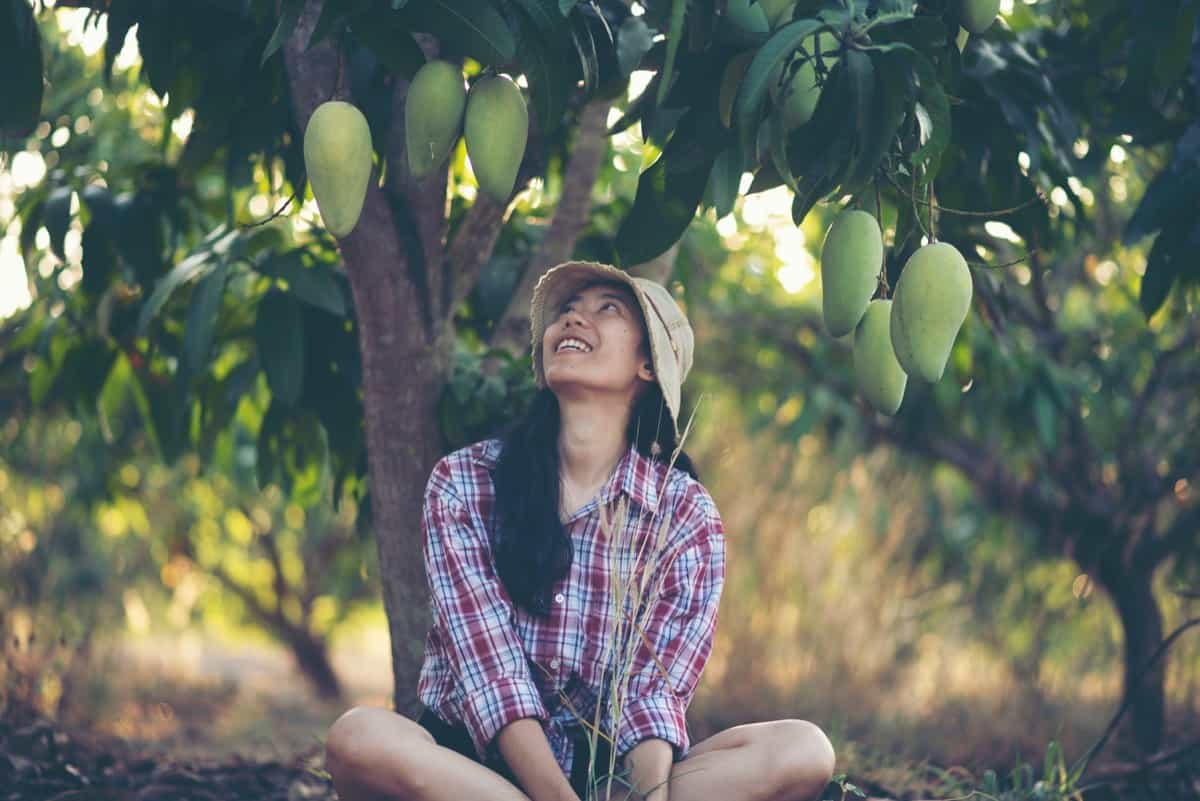
Assuming an average yield of 10 tons per acre and a conservative selling price of ₹30 per kilogram, you could potentially generate total revenue of ₹3,00,000 from your Mango farm. After considering the lower end of the cost estimate, which is around ₹75,000 per acre for cultivation expenses, your net profit could land at approximately ₹2,25,000 per acre.
Conclusion
Mango farming holds great importance as it provides livelihoods for many farmers around the world. Mango farming supports food security by providing a sustainable source of nutrition for individuals around the world. With proper care and cultivation practices, Mango orchards can thrive for generations to come, ensuring a steady supply of this beloved fruit.
- Economical Aquaculture: A Guide to Low-Budget Fish Farming
- 15 Common Planting Errors That Can Doom Your Fruit Trees
- How to Make Houseplants Bushy: Effective Tips and Ideas
- Innovative Strategies for Boosting Coconut Pollination and Yield
- Pollination Strategies for Maximum Pumpkin Yield
- The Complete Guide to Chicken Fattening: Strategies for Maximum Growth
- Natural Solutions for Tulip Problems: 100% Effective Remedies for Leaf and Bulb-Related Issues
- Revolutionizing Citrus Preservation: Towards a Healthier, Greener Future
- Natural Solutions for Peony Leaf and Flower Problems: 100% Effective Remedies
- Maximizing Profits with Avocado Contract Farming in India: A Comprehensive Guide
- Natural Solutions for Hydrangea Problems: 100% Effective Remedies for Leaf and Flowers
- The Ultimate Guide to Choosing the Perfect Foliage Friend: Bringing Life Indoors
- From Sunlight to Sustainability: 15 Ways to Use Solar Technology in Agriculture
- The Ultimate Guide to Dong Tao Chicken: Exploring from History to Raising
- The Eco-Friendly Makeover: How to Convert Your Unused Swimming Pool into a Fish Pond
- Mastering the Art of Delaware Chicken Farming: Essentials for Healthy Backyard Flocks
- 20 Best Homemade Fertilizers for Money Plant: DIY Recipes and Application Methods
- How to Craft a Comprehensive Free-Range Chicken Farming Business Plan
- Brighten Your Flock: Raising Easter Egger Chickens for Beauty and Bounty
- How to Optimize Your Poultry Egg Farm Business Plan with These Strategies
- Subsidy for Spirulina Cultivation: How Indian Government Schemes Encouraging Spirulina Farmers
- Ultimate Guide to Raising Dominique Chickens: Breeding, Feeding, Egg-Production, and Care
- Mastering the Art of Raising Jersey Giant Chickens: Care, Feeding, and More
- Ultimate Guide to Raising Legbar Chickens: Breeding, Farming Practices, Diet, Egg-Production
- How to Raise Welsummer Chickens: A Comprehensive Guide for Beginners
- How to Protect Indoor Plants in Winter: A Comprehensive Guide
- Ultimate Guide to Grow Bag Gardening: Tips, Tricks, and Planting Ideas for Urban Gardeners
- Guide to Lotus Cultivation: How to Propagate, Plant, Grow, Care, Cost, and Profit
- Agriculture Drone Subsidy Scheme: Government Kisan Subsidy, License, and How to Apply Online
- Ultimate Guide to Raising Araucana Chickens: Breed Profile, Farming Economics, Diet, and Care
- Bringing Hydroponics to Classroom: Importance, Benefits of Learning for School Students
- Ultimate Guide to Raising Polish Chickens: Breed Profile, Farming Economics, Diet, and Care
- Ultimate Guide to Raising Australorp Chickens: Profile, Farming Economics, Egg Production, Diet, and Care
- Silkie Chicken Farming: Raising Practices, Varieties, Egg Production, Diet, and Care
- Sussex Chicken Farming: Raising Practices, Varieties, Egg Production, Diet and Care
- Homemade Feed Formulations for Livestock: Discover Cost-effective Starter to Finisher Feed Recipes
It is better you contact organic vegetable stores in your local area.
Hi,
I want to grow mango trees (Kesar) in my farms in solapur(Maharashtra). I don’t want to buy small plants and wait for 3 to 4 years to get the fruit. I want to by those plants which can give me good amount of fruits in the next year of plantation, meaning that, if I plant trees in 2018, I want to yield good amount of mangoes in 2019. So,I am confused, how old plant should I buy and what height. I will be buying grafted tree, Please, let me know how many years old plant and what should be the height of the plant, which I should buy. Or tell me any office name in Pune or Solapur where I can get this information.
We don’t suggest to plant already grown up plants in nursery bags/beds. The growth rate and yield would be very less if you buy 3 years plant for your field. 6 months old is good to plant for better root establishment and strong framework.
How to give you information about our mangoes?.
Ok after I planted my mongo nursery , can I plant a rice for example after three months.?
What’s the best way to find which alternate crop we can try with our Dashheri variety of mangoes. We are located at the edge of greater noida besides dasna but we don’t want to impact the current yield of mangoes. Please suggest.
Also for some reason from what i know, Mango crop is an alternating one with less yield each alternate year. Is there a way to increase yield of the crop or this is the known behavior of Mango trees.
Are you asking alternate mango varieties? or other different fruit crops?
What are the best mango variety to plant in Hyderabad, Telangana climate? And alphanso can be grown in Hyderabad climate. Please reply.
Well, many people are growing different varieties of mangoes near and around Hyderabad like Mallika, Dasheri, Sundari, Rasalu, Totapuri and mainly Banganapalli Mangoes. Banganapalli can fetch more profits as market demand for this fruit is high.
1) If the yield of a grafted mango tree declines after 40 to 50 years, then how much yield per plant can we expect after 40-50 years? 2) What do farmers do of trees that are 40-50 years old and are less productive?
Nothing you can do about it, that’s the way the tree ends its life.
I am interested to plant mango trees in an area of 4 acres and am looking for technical help to know how and cost of planting etc.. Can you guide me in this field.
Thanks
There are many nursery people who can supply Mango Seedlings or Sapplings can help you to set up a mango farm.
Hi, we have planted mango trees last 2 years back, but mango trees are very small size can you help me out some tips.
Check the soil for nutrient. Make sure the plants are provided with good water. Usually, In mango orchard, farmers apply well decomposed Vermicompost or cow dung (Farmyard manure). I am not sure the trees are pruned properly.
hello,
I am interested in growing mango trees. Would like to know which type of mangoes can be grown in betam, Madhya Pradesh keeping the climate condition in mind. What is the best option for business and how to go about it.
We have planted 200 mango plants. Please inform how to apply manures. And their periodicity. Thanks.
Usually, mango plants should be fed in the rainy season with vermicompost or cow dung. This can be done in yearly basis after harvest of summer and during monsoon time.
We don’t have personal support at this point in time. Mango farming is not that much feasible as we too have in the surroundings of Hyderabad.
We want to create Ultra density mango plantation. I understand that there are 700 trees/acre. Is it advisable for kesar mangoes
It is better to go for normal distances rather going for ultra density. Once the mango treed attain 5 to 6 feet, they cover the surrounding area.
Is there a complete mango farming guide (preferably in Hindi), covering the whole yearly cycle and possible issues and remedies. How to start a new season, soil prep, fertilizers, insecticides, etc., for every stage and all kinds of issues, until plucking and restarting the cycle next year.
Read this: Mango Farming Project Report.
I have more than 2 Acres Mango plantation age group from 4 years to 35 years old trees. I want to start goat farming as well hybrid vegetable farming by using green house.
Thanks
Hi
I want to start mango farming in my native (Satara).I am ready to spare 20 gunta farm for this project.I am biginer in this field.
Please suggest me best variety of plants for cultivation.Also let me know the approximate profits after 5 years.
My Field is situated in a flood area , although a lot of mango trees are there.but nobody have done it commercially. Can I go for mango planting.and if yes how?
Mango trees cannot survive in waterlogged areas. They get rootrot diseases due to heavy water at the root system. If the land is sandy loam where water draining happens quickly, there won’t be any issue. However,flooding prone areas are not recommended.
Thanks for your valuable suggestion.can you suggest something i can plant in my land
Hi,
I have 3 acres of sandy soil land, I am planning to do mango plantation in that land. Can you please suggest sandy soil is ok or not for mango plantation
Regards,
Reddy
Sandy soil works well with good organic matter for mango orchard. Read this: Mango Farming Project Report.
I planted mango pulp collecting from
govt horticulture officebut some trees are not totally flowering & fruiting though I am waiting for ten years so what can I do .whetherI will cut those trees,any step ther to flowering those trees.any medicine ? Please give me good veritable mango grafted plup address o phone number to collect.
Sir, Quite Interesting to see well educated people are Plunged into Farming sector. Wow really India is changing..? I left the Job in Mumbai as Chief executive & started Farming in Karnataka with Areca in 9 Acres,
happy life leading , without Pollution smoke, noise, Dust any thing such. regards.
You are a excellent Job sir, Regards.
What’s the procedure of mango planting. means plant, age,climate-wise variety.basal does while planting and other details.
hi there ,
a few questions.
a. Can the land once sown with mango orchard advised to be used for another crop or farm?
b. What kind of soil is the best for mango plantation.
Thanks,
Farzana Nahid
Red Sandy Loam Soils are best for mango plantation. However, Black soils with high water retention are not advisable. Yes you can use the soil for other crops. however, enriching the soil with organic matter is a good idea for getting a higher yield of any crop.
Thanks for the explicit explanation of Mango farming, mango is versatile and eaten by a large proportion of people. Making it one of the lucrative business to venture in.
Hi, I’m keen on starting mango farming on my land. Can you please connect on email?
Sir, in one acr how many trees should I plant?
How many alphanso mango can I get per tree?
Understand every tree gives alternate year mango is this true.
nice to see many people are interest in farming mango. my mango tree has ageing of 15yrs mango size seems to small this year. can you guide me fertilizer to increase mango size. i am located in tamil nadu Gummidipoondi.
Dear Reddy,
I ‘m planning for Mallika mango plantation near Bangalore -Tumkur highway.
can you please suggest which variety is better for planting and good yield.
In Maalika or Banisha, which one has good yield?
Regards,
Yousuff
Jagdish Ji,
Thanks for the useful information. My land does not have water, our multiple attempts at borewell have been futile. Is it possible to grow a mango orchard by irrigating it through water tankers. How much is the water demand per tree per month.
Thank You
I have two acres land I want plant mango trees but water is hard water some what salty in water precipitation is there will it suitable for tthis
Mango is grown in Tropical & subtropical Climate. Please let me know that for healthy plants an d good crop need a suitable SUN LIGHT INTENSITY during Summer and Winter.
Please let me know Required Light Intensity in Summer + Winter and rainy season .
Further I would like to know maximum an d minimum Temperature in Summer and Winter.
Than ks
I Want to Start Mango Farming May Native Area is Lucknow and Please Suggest What is Best Variaty and What is Area to Earn 2 to Three Lack Per Season. Can We Also Use Empty Aren B/w Trees for Other Frouit Like Papaya ,aloobukhara Etc.
Please check this: High Yield Hybrid Mango Varieties in India
Hi
I am planning to plant mango plants in sandy soil 100 plants in 1 acre with spacing of 15 feet
Need suggestion for on planting what to be filled in pits like any animal manure? Or just same soil digged out pits?
Need suggestion for watering for plants planted in July from day1 how often need wAtering in first 1 year
Need suggestion how often we can input animal manure in first 1 year
I am buying a mango orchard. About 2 acres. 85 trees. What should be the yield? It seems owner has used steroids to get produce. What should i do to detoxify?